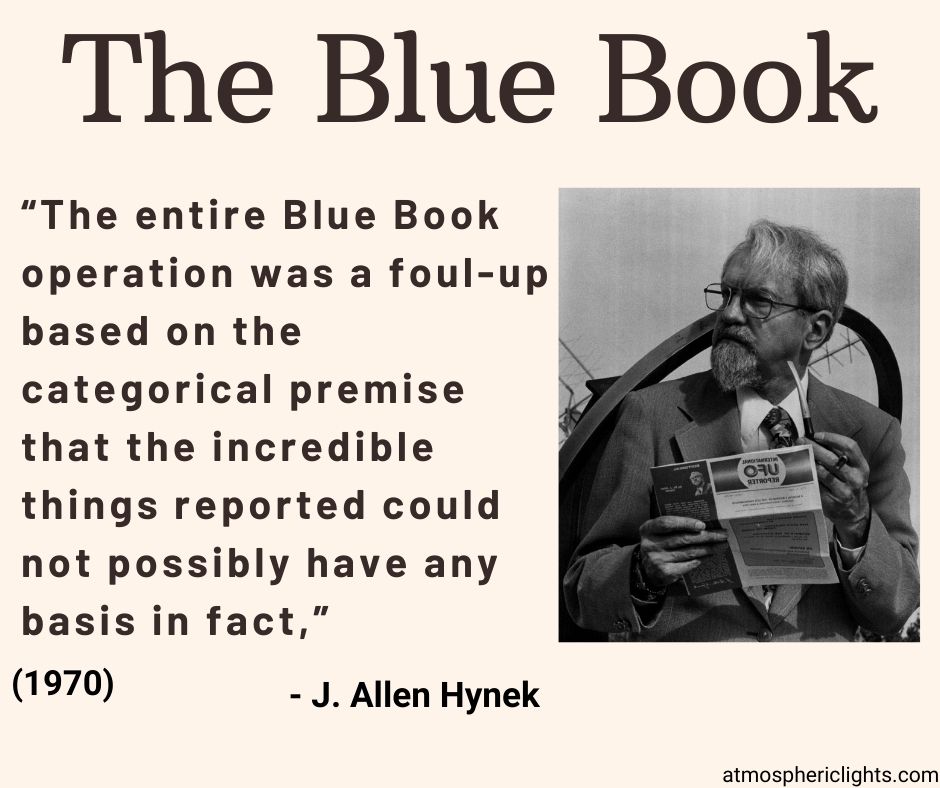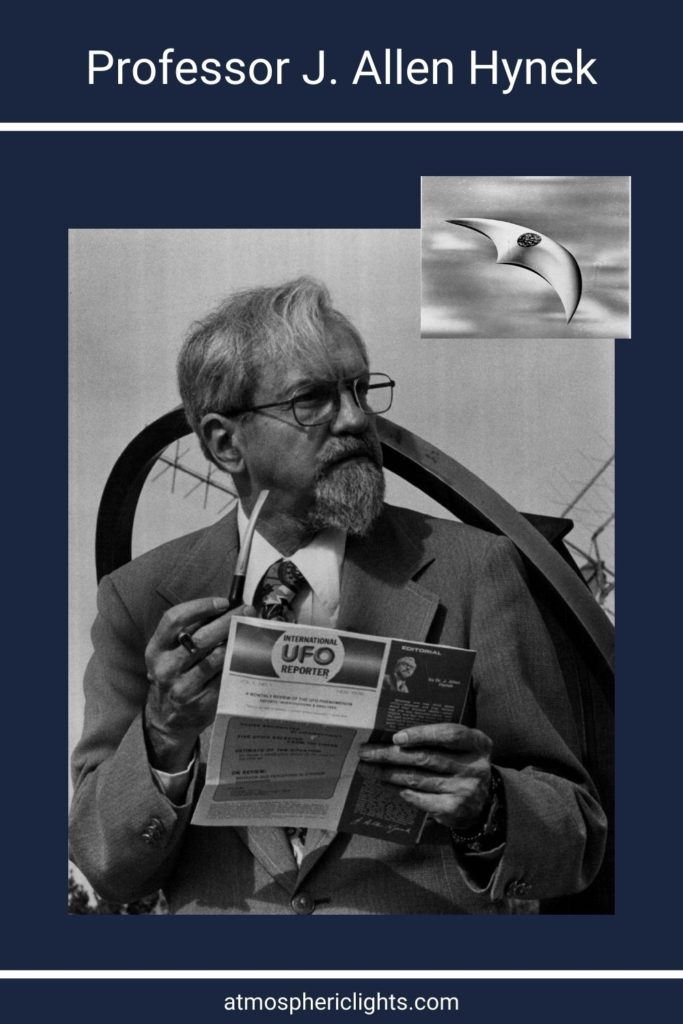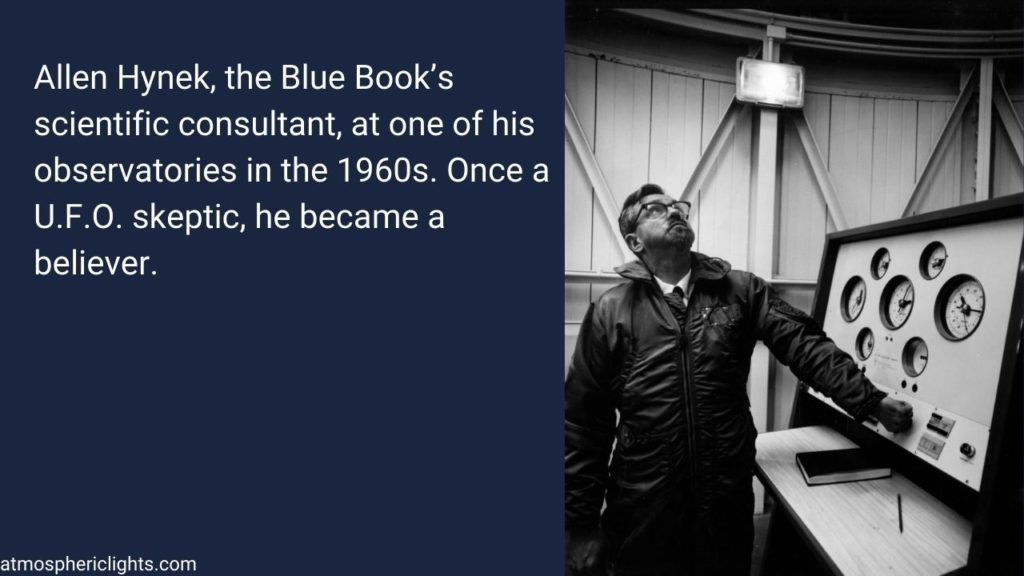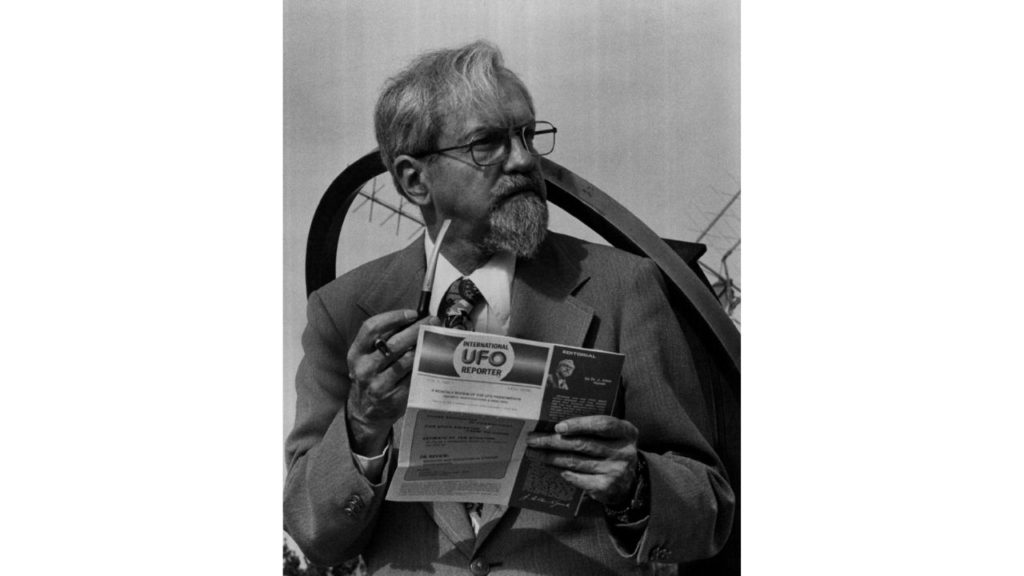In this article, I will dig into the interesting Allen Hynek. Learn what he thought about the UFO phenomenon. Allen Hynek (Born on May 1, 1910 – Died on April 27, 1986). He was an American professor and astronomer.
Hynek was very well known for also being a ufologist. But he is perhaps best remembered for his UFO research.
Allen Hynek acted as a scientific advisor to UFO studies undertaken by the U.S. Air Force. This was under two projects named: Project Sign (1947–1949) and Project Blue Book (1952–1969).
He conducted his own independent UFO research in later years, developing the “Close Encounter” classification system.
He was among the first people to conduct scientific analysis of reports, especially trace evidence purportedly left by UFOs.

Early Life
Allen was born in Chicago to Czech parents. In 1931, he received a B.S. from the University of Chicago.
Later, In 1935, he completed his Ph.D. in astrophysics at Yerkes Observatory. Furthermore, in 1936 joined the Department of Physics and Astronomy at The Ohio State University.
He later specialized in the study of stellar evolution and the identification of spectroscopic binary stars.
Career
Throughout World War II, he was a civilian scientist at the Johns Hopkins Applied Physics Laboratory, where he served to develop the United States Navy’s radio proximity fuze.
And after the war, he returned to the Department of Physics and Astronomy at Ohio State, rising to full professor in 1950. In 1953, Allen proposed a report on the fluctuations in starlight and daylight’s brightness and daylight, highlighting daytime observations.
Moreover, In 1956, he left to join Professor Fred Whipple, the Harvard astronomer, at the Smithsonian Astrophysical Observatory, coupled with the Harvard Observatory at Harvard.
He had the duty of directing the tracking of an American space satellite, a project for the International Geophysical Year in 1956 and after that.
In addition to over two hundred teams of amateur scientists worldwide that were part of Operation Moonwatch, there were also twelve photographic Baker-Nunn stations.
A special camera was devised for this job, and a model was built and tested and then stripped apart again when, on October 4, 1957, the Soviet Union launched Sputnik 1.
After finishing his work on the satellite program, he went back to teaching. He was taking the professor and chairman of the astronomy department at Northwestern University in 1960.

His Skepticism
In response to many reports of UFOs or “flying saucers,” the United States Air Force established Project Sign in 1948 to investigate sightings of those UFOs or unidentified flying objects.
He was contacted to act as a scientific consultant to Project Sign. He examined UFO reports and determined whether the enigmatic phenomena described therein suggested known astronomical objects.
So, when Project Sign hired Hynek, he was skeptical of those UFO reports.
He assumed that they were made by unreliable witnesses or persons who had misidentified human-made or ordinary objects.
In 1948, He said that “the whole subject seems utterly ridiculous” and described it as a fad that would soon pass.
Moreover, in his 1977 book, Hynek said that he enjoyed his role as a debunker for the Air Force. He also confesses that debunking was what the Air Force expected of him.

This post may contain affiliate links, and as an Amazon Associate, I earn from qualifying purchases that help keep this content free.
Change of Opinion
In April 1953, Allen wrote a report for the Journal of the Optical Society of America titled “Unusual Aerial Phenomena,” which included one of his famous statements – “Ridicule is not part of the scientific method, and the people should not be taught that it is.
The steady flow of UFO reports, often made in concert by reliable observers, raises scientific obligation and responsibility questions.”
“Is there any residue that is worthy of scientific attention? If there isn’t, does not an obligation exist to say so to the public, not in words of open ridicule but seriously, but to keep faith with the trust the public places in science and scientists?”
Moreover, in 1953, Hynek was an associate member of the Robertson Panel, which concluded nothing strange about UFOs.
A public relations campaign should be undertaken to debunk the UFO subject and reduce the public interest. Allen would later regret that the Robertson Panel had helped make UFOs a disreputable field of study.
As UFO reports remained to be made, some of the statements, particularly by military pilots and police officers, were very puzzling to Allen.
He once said, “As a scientist, I must be mindful of the lessons of the past; because all too often it has happened that matters of great value to science were overlooked because the new UFO phenomenon did not fit the accepted scientific outlook of the time.”
Furthermore, in a 1985 interview, when asked what caused his change of opinion, he responded, “Two things.
One was the entirely negative and recalcitrant attitude of the Air Force. They wouldn’t give UFOs the possibility of existing even if they were flying up and down the street in broad daylight because everything had to have a profound explanation.
Allen began to resent that, even though I felt the same way because he still thought they weren’t going about it in the best way.
He thought he couldn’t assume that everything is black, no matter what. Furthermore, the caliber of the witnesses began to trouble him.
Quite a few instances were reported by military pilots and he knew them to be pretty well-trained, so this is when Allen first began to think that maybe there was something to all UFO sightings.
Allen remained with Project Sign after it became Project Grudge (though he was far less involved in Grudge than in Sign).
Project Grudge was later replaced with Project Blue Book in 1952, and he remained a scientific consultant.
The US Air Force Captain Edward J. Ruppelt, Blue Book’s first director, held Allen in high regard: “He was one of the most impressive scientists I met while working on this UFO project, and I met a good many.
Hynek didn’t do two things that some of those involved did: give you the answer before he knew the question, or immediately begin to expound on his accomplishments in the field of expertise and science.”
Though he thought Ruppelt was a competent director who steered Project Blue Book in the right direction, Ruppelt headed Blue Book for just a few years.
He has stated his opinion that after Ruppelt’s departure, Project Blue Book was little more than a public relations exercise, moreover noting that little or no research was undertaken using the scientific method.
The Hynek UFO Report: The Authoritative Account of the Project Blue Book Cover-Up. (Amazon book).

Turnaround
Allen began occasionally quarreling publicly with the results of Blue Book. By the early 1960s, after about a decade and a half of study, Clark records that “Allen’s apparent turnaround on the UFO question was an open secret.”
Just after Blue Book was formally dissolved, did he speak more openly about his “UFO-turnaround” Hynek considered that his personality was a factor in the Air Force keeping him on as a consultant for over two decades.
Some other ufologists thought that Allen was dishonest or even duplicitous in his turnaround.
Physicist James E. McDonald wrote to Allen in 1970, admonishing him for what McDonald saw as his lapses. He was suggesting that, when evaluated by later generations, retired Marine Corps Major Donald E. Keyhoe would be viewed as a more objective, honest, and scientific ufologist.
Throughout the late stages of Blue Book in the 1960s, Allen began speaking openly about his disagreements and disappointments with the Air Force. Amongst the causes about which he openly disagreed with the Air Force were the highly advertised Portage County UFO chase.
Numerous police officers chased a UFO for half an hour. And the encounter of Lonnie Zamora, the police officer who reported a UFO encounter with a metallic, egg-shaped aircraft near Socorro, New Mexico.
Moreover, in March 1966 in Michigan, two days of mass UFO sightings were reported and got significant publicity.
After examining the reports, Hynek offered a provisional hypothesis for some of the sightings: a few about hundred witnesses had mistaken swamp gas for something more spectacular.
At the press conference where he announced, Allen repeatedly and energetically stated that swamp gas was a likely explanation for only a portion of the Michigan UFO reports and not for UFO reports in general.
But much to his dismay, Allen’s qualifications of his hypothesis were largely ignored, and the term swamp gas was repeated ad infinitum concerning UFO reports. The explanation was subject to national scorn.
In his reply dated October 7, 1968, to a request for scientific recommendations regarding Blue Book from Colonel Raymond Sleeper, commander of the USAF Foreign Technology Division, he noted that Blue Book suffered from numerous procedural problems and a lack of resources, which rendered its efforts “totally inadequate.”
He also noted that one wag had bestowed Blue Book the epithet of “Society for the Explanation of the Uninvestigated.”
Founder of the Center for UFO Studies (CUFOS)
Allen Hynek was the founder and first head of the Center for UFO Studies (CUFOS). Founded in 1973 in Evanston, Illinois (but is now based in Chicago).
CUFOS advocates for scientific analysis of UFO cases. CUFOS’s extensive archives include valuable files from civilian research groups such as NICAP, one of the most famous UFO research groups of the 1950s and 1960s.
